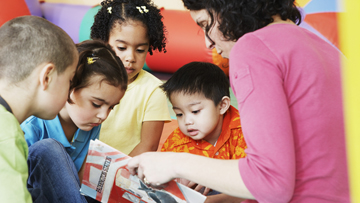|
Volume : VI, Issue : III, April - 2016 ROLE OF CRUCIAL FACTORS IN LANGUAGE PROGRESSION OF CHILDREN Santosh Sangwan., Anju Manocha. By : Laxmi Book Publication Abstract : The language, a child learns, is generally determined by the society or culture in which he is born, more specifically, by his home, school or educational system and community. Learning is a term that describes the activities and strategies through which children learn. These can be identified through exploration, experimentation and discovery Keywords : Article : Cite This Article : Santosh Sangwan., Anju Manocha.(2016). ROLE OF CRUCIAL FACTORS IN LANGUAGE PROGRESSION OF CHILDREN. Indian Streams Research Journal, Vol. VI, Issue. III, http://isrj.org/UploadedData/7963.pdf References : - Berget JA and Bryant PE 2000. It does not matter whether onset and Rime predicts reading better than phoneme awareness or vice versa. Journal of experimental Child Psychology.82: 41-46
- 5.Hayiou-Thomas ME 2008. Genetic and environmental influences on early speech, language and literacy development. Journal of Communication Disorders. 41 (5) : 397–408.
- Nuray Bayar Muluk Birgul Bayoglu Banu Anlar 2014. Language development and affecting factors in 3- to 6-year-old children. Otorhinolaryngol. 271:871–878
- Reynell Joan 1985. Reynell Developmental language Scales. 2nd Revision. NFER – NELSON Publishers
- Riley J, Burrel and MccallumB 2004. Developing the spoken language skills of reception class children in two multicultural, inner-city primary school. British Education Research Journal.30: 657-673.
- Sangwan S, Sangeeta and Punia S 2000. Effect of ecological factors: contributing for language performance. Journal of Human Ecology.11 (5): 343-346
- Guo G and Harris KM 2000. The mechanisms mediating the effects of poverty on Children’s intellectual development. Demograph, pubmed. 37 (4): 431-447.
- Gonzalez V 2001. The role of socioeconomic and socio-cultural factors in language minority children’s development: An ecological view. Bilingual Research Journal, winter and Spring. 25 (1&2): 1-17.
- Bradely RH and Corwyn RF 2002. Socioeconomic status and child development. Annual Review of Psychology. 53: 371-399
- Guo G and Harris KM 2000. The mechanisms mediating the effects of poverty on Children’s intellectual development. Demograph, pubmed. 37 (4): 431-447.
- Guo G and Harris KM 2000. The mechanisms mediating the effects of poverty on Children’s intellectual development. Demograph, pubmed. 37 (4): 431-447.
- Guo G and Harris KM 2000. The mechanisms mediating the effects of poverty on Children’s intellectual development. Demograph, pubmed. 37 (4): 431-447.
- Guo G and Harris KM 2000. The mechanisms mediating the effects of poverty on Children’s intellectual development. Demograph, pubmed. 37 (4): 431-447.
- Bradely RH and Corwyn RF 2002. Socioeconomic status and child development. Annual Review of Psychology. 53: 371-399
- Berget JA and Bryant PE 2000. It does not matter whether onset and Rime predicts reading better than phoneme awareness or vice versa. Journal of experimental Child Psychology.82: 41-46
- 5.Hayiou-Thomas ME 2008. Genetic and environmental influences on early speech, language and literacy development. Journal of Communication Disorders. 41 (5) : 397–408.
- Nuray Bayar Muluk Birgul Bayoglu Banu Anlar 2014. Language development and affecting factors in 3- to 6-year-old children. Otorhinolaryngol. 271:871–878
- Reynell Joan 1985. Reynell Developmental language Scales. 2nd Revision. NFER – NELSON Publishers
- Riley J, Burrel and MccallumB 2004. Developing the spoken language skills of reception class children in two multicultural, inner-city primary school. British Education Research Journal.30: 657-673.
- Sangwan S, Sangeeta and Punia S 2000. Effect of ecological factors: contributing for language performance. Journal of Human Ecology.11 (5): 343-346
- Gonzalez V 2001. The role of socioeconomic and socio-cultural factors in language minority children’s development: An ecological view. Bilingual Research Journal, winter and Spring. 25 (1&2): 1-17.
- Berget JA and Bryant PE 2000. It does not matter whether onset and Rime predicts reading better than phoneme awareness or vice versa. Journal of experimental Child Psychology.82: 41-46
- Bradely RH and Corwyn RF 2002. Socioeconomic status and child development. Annual Review of Psychology. 53: 371-399
- Gonzalez V 2001. The role of socioeconomic and socio-cultural factors in language minority children’s development: An ecological view. Bilingual Research Journal, winter and Spring. 25 (1&2): 1-17.
- Berget JA and Bryant PE 2000. It does not matter whether onset and Rime predicts reading better than phoneme awareness or vice versa. Journal of experimental Child Psychology.82: 41-46
- 5.Hayiou-Thomas ME 2008. Genetic and environmental influences on early speech, language and literacy development. Journal of Communication Disorders. 41 (5) : 397–408.
- Nuray Bayar Muluk Birgul Bayoglu Banu Anlar 2014. Language development and affecting factors in 3- to 6-year-old children. Otorhinolaryngol. 271:871–878
- Reynell Joan 1985. Reynell Developmental language Scales. 2nd Revision. NFER – NELSON Publishers
- Riley J, Burrel and MccallumB 2004. Developing the spoken language skills of reception class children in two multicultural, inner-city primary school. British Education Research Journal.30: 657-673.
- Bradely RH and Corwyn RF 2002. Socioeconomic status and child development. Annual Review of Psychology. 53: 371-399
- Sangwan S, Sangeeta and Punia S 2000. Effect of ecological factors: contributing for language performance. Journal of Human Ecology.11 (5): 343-346
- 5.Hayiou-Thomas ME 2008. Genetic and environmental influences on early speech, language and literacy development. Journal of Communication Disorders. 41 (5) : 397–408.
- Nuray Bayar Muluk Birgul Bayoglu Banu Anlar 2014. Language development and affecting factors in 3- to 6-year-old children. Otorhinolaryngol. 271:871–878
- Reynell Joan 1985. Reynell Developmental language Scales. 2nd Revision. NFER – NELSON Publishers
- Riley J, Burrel and MccallumB 2004. Developing the spoken language skills of reception class children in two multicultural, inner-city primary school. British Education Research Journal.30: 657-673.
- Sangwan S, Sangeeta and Punia S 2000. Effect of ecological factors: contributing for language performance. Journal of Human Ecology.11 (5): 343-346
- Guo G and Harris KM 2000. The mechanisms mediating the effects of poverty on Children’s intellectual development. Demograph, pubmed. 37 (4): 431-447.
- Gonzalez V 2001. The role of socioeconomic and socio-cultural factors in language minority children’s development: An ecological view. Bilingual Research Journal, winter and Spring. 25 (1&2): 1-17.
|
Article Post Production
No data exists for the row/column.
|